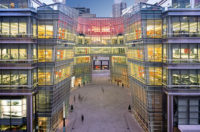The contractor for the $453-million steel-superstructure portion of the widening of the Huey P. Long Bridge in New Orleans is working out the last details of an erection sequence that is faster, safer and interferes less with motor and marine traffic than the stick-build sequence the owner originally proposed.


MTI, a joint venture of Massman Construction Co., Kansas City; Traylor Bros. Inc., Evansville, Ind.; and IHI Inc., New York City, with consulting engineer HNTB Corp, Kansas City, have devised a plan to barge-position, lift and connect pre-assembled trusses on three of the Mississippi River bridge’s four spans. The finished bridge will be “triple-barrel,” with four parallel trusses separating two roadways and a center rail line. “Single- barrel trusses have been hoisted like this before, but I don’t believe anyone has ever hoisted triple-barrel,” says Steve Underwood, MTI project manager.
The Louisiana Dept. of Transportation and Development, the marine industry, U.S. Coast Guard and U.S. Army Corps of Engineers have approved the plan, Underwood says. “The marine industry is as excited as we are,” he says. Stick-built would have taken a lot of falsework on the river, which would increase marine traffic restrictions and hazards. The plan improves safety for the contractor as well, says Sean McInerney, MTI’s assistant project engineer, because workers access the job from the bridge, not falsework on the river.
“Another reason we went with this system is to take the stresses away from the existing truss,” Underwood says. “That was one of the selling points to the owner. It puts the existing structure in a safer condition at all times.”
There is no way to tie the two independent chords together and lift around the existing operative bridge, so MTI devised two U-shaped stability frames to hold the trusses plumb. The base of each frame is formed by 6-ft-deep by 160-ft-long box-section floor beams. Towers, 100 ft tall, 18 ft deep and 113 ft wide, are braced to the beams to hold the trusses in position.
Prior to erection, MTI will set 140-ft- wide horn beams over the bridge’s existing trusses. Once the new trusses are on the bridge bearings, the horn beams will hold and brace them until secondary members are installed and other attachments are made. The trusses will be lifted by four 900-ton lifting-strand jacks placed on towers over the bridge bearings. They will be guided into place by 150-ton horizontal jacks on the floor beams. The heaviest span, with its stability frames, is 4.9 million lb, McInerney says.
MTI expects the first truss erection will take about 48 hours to position, lift and attach, Underwood says. “Within those 48 hours, rail and motor traffic will continue, and there will be only 20 hours of full closure to marine traffic.”
“We expect to start assembling stability frames in late September and receive permanent steel by late July or early August,” Underwood says. MTI plans to use the new sequence to erect the east-bank anchor span in April 2010.











